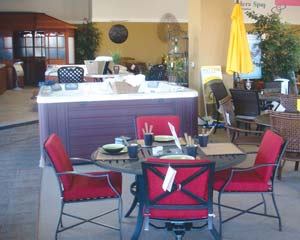Not long ago, the Phoenix metro area was home to 60 hot tub stores. Today there are less than 20.
Across the country in Washington, D.C., one of the area’s largest spa retailers — Home Escapes — shuttered its three-store operation in late summer after 23 years in business.
Dealers are closing shop in virtually every community nationwide, reflecting a recessionary economy as well as an industry in the grip of a steep, multiyear sales decline.
It begs the question: How are hot tub makers staying afloat?
“Honestly, I don’t know how a number of these manufacturers have hung on as long as they have,” said Lauren Stack, director of public affairs and industry promotion for the Association of Pool & Spa Professionals.
“The industry has bigger issues than just a lack of available credit,” she added. “To emerge from this successfully, you have to overcome the fact that you’re a luxury item and a user of energy. Plus, I think retailers aren’t committing the same kind of floor space to our category anymore, and that lessens the exposure to the consumer.”
Though statistics on unit sales are hard to come by, industry experts estimate approximately 150,000 hot tubs will be sold across the country this year. Compare that with 2004-05 numbers, which topped out at as much as three times that figure, according to APSP officials.
“If we dip below 100,000 units annually, I can’t see where this industry can sustain 60 to 70 manufacturers,” Stack said.
As for which companies could be most susceptible to a shakeout, it all depends on who you ask.
Some believe the larger manufacturers are under more stress to keep their businesses fit. Then again, the smaller, regional players don’t typically have the same brand recognition or local dealer relationships as their bigger counterparts.
“Ultimately, I think there will be fewer brands out there,” said Jim Johnston, vice president of sales and marketing at manufacturer Marquis Spas in Independence, Ore. “We’re probably a year away from seeing some true positive momentum, and there has to be immense pressure on a number of manufacturers in terms of their cash flow. It’s not a good situation right now.”
For their part, many dealers have reduced spa-heavy displays and product lines.
“We’ve known for some time that retail has been in decline, and we see it in our market, too. It’s not a good time to be a spa-only retailer,” said Brenda Murr, vice president of Mermaid Pool, Spa & Patio in Anderson, Ind.
“It wouldn’t surprise me to see some product lines disappear or some manufacturers go away,” she added. “We’ve all had to rediscover our niches in this economy.”
A shrinking retail base puts more strain on manufacturers, and the industry may not see positive movement for some time, even if an overall recovery takes hold in the next six to 12 months.
“We’re a high-ticket, discretionary item, and the credit market remains tight,” said Mike Dunn, vice president of sales and marketing at Watkins Manufacturing in Vista, Calif. “We could be lagging behind in that respect.”
“It’s a difficult climate,” he added, “and there’s going to come a point where something has to give. But it does feel to us that perhaps we’ve hit the bottom, though it would be nice to see some stability.”



